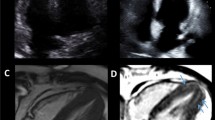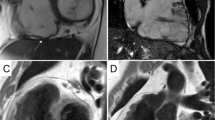Abstract
Objectives
Immune checkpoint inhibitor (ICI)–associated myocarditis is a potentially fatal complication. Sparse published researches evaluated the prognostic value of cardiovascular magnetic resonance feature tracking (CMR-FT) for ICI-associated myocarditis.
Methods
In the single-center retrospective study, 52 patients with ICI-associated myocarditis and CMR were included from August 2018 to July 2021. The ICI-associated myocarditis was diagnosed by using the clinical criteria of the European Society of Cardiology guidelines. Major adverse cardiovascular events (MACE) were comprised of cardiovascular death, cardiogenic shock, cardiac arrest, and complete heart block.
Results
During a median follow-up of 171 days, 14 (27%) patients developed MACE. For patients with MACE, the global circumferential strain (GCS), global radial strain (GRS), global longitudinal strain (GLS), and left ventricular ejection fraction (LVEF) were significantly worse and native T1 values and late gadolinium enhancement (LGE) extent were significantly increased, compared with patients without MACE (p < 0.05). The GLS remained the independent factor associated with a higher risk of MACE (hazard ratio (HR): 2.115; 95% confidence interval (CI): 1.379–3.246; p = 0.001) when adjusting for LVEF, LGE extent, age, sex, body mass index, steroid treatment, and prior cardiotoxic chemotherapy or radiation. After adjustment for LVEF, the GLS remained the independent risk factor associated with a higher rate of MACE among patients with a preserved LVEF (HR: 1.358; 95% CI: 1.007–1.830; p = 0.045).
Conclusions
GLS could provide independent prognostic value over GCS, GRS, traditional CMR features, and clinical features in patients with ICI-associated myocarditis.
Key Points
• The global circumferential strain (GCS), global radial strain (GRS), and global longitudinal strain (GLS) by cardiovascular magnetic resonance feature tracking were significantly impaired in patients with an immune checkpoint inhibitor (ICI)–associated myocarditis.
• GLS was still significantly impaired in patients with preserved left ventricular ejection fraction.
• The worse GLS was an independent risk factor over GCS, GRS, traditional CMR features, and clinical features for predicting major adverse cardiovascular events in patients with ICI-associated myocarditis.




Similar content being viewed by others
Abbreviations
- CMR-FT:
-
Cardiovascular magnetic resonance feature tracking
- EMB:
-
Endomyocardial biopsy
- GCS:
-
Global circumferential strain;
- GLS:
-
Global longitudinal strain
- GRS:
-
Global radial strain
- ICC:
-
Intraclass correlation coefficient
- ICIs:
-
Immune checkpoint inhibitors
- LGE:
-
Late gadolinium enhancement
- LVEF:
-
Left ventricular ejection fraction
- MACE:
-
Major adverse cardiac events
- NT-proBNP:
-
N-terminal pro–B-type natriuretic peptide
References
Johnson DB, Balko JM, Compton ML et al (2016) Fulminant myocarditis with combination immune checkpoint blockade. N Engl J Med 375:1749–1755
Ganatra S, Neilan TG (2018) Immune checkpoint inhibitor-associated myocarditis. Oncologist 23:879–886
Zhang L, Awadalla M, Mahmood SS et al (2020) Cardiovascular magnetic resonance in immune checkpoint inhibitor-associated myocarditis. Eur Heart J 41:1733–1743
Ferreira VM, Schulz-Menger J, Holmvang G et al (2018) Cardiovascular magnetic resonance in nonischemic myocardial inflammation: expert recommendations. J Am Coll Cardiol 72:3158–3176
Thavendiranathan P, Zhang L, Zafar A et al (2021) Myocardial T1 and T2 mapping by magnetic resonance in patients with immune checkpoint inhibitor-associated myocarditis. J Am Coll Cardiol 77:1503–1516
Eitel I, Stiermaier T, Lange T et al (2018) Cardiac magnetic resonance myocardial feature tracking for optimized prediction of cardiovascular events following myocardial infarction. JACC Cardiovasc Imaging 11:1433–1444
Romano S, Judd RM, Kim RJ et al (2018) Feature-tracking global longitudinal strain predicts death in a multicenter population of patients with ischemic and nonischemic dilated cardiomyopathy incremental to ejection fraction and late gadolinium enhancement. JACC Cardiovasc Imaging 11:1419–1429
Fischer K, Obrist SJ, Erne SA et al (2020) Feature tracking myocardial strain incrementally improves prognostication in myocarditis beyond traditional CMR imaging features. JACC Cardiovasc Imaging 13:1891–1901
Porcari A, Merlo M, Crosera L et al (2020) Strain analysis reveals subtle systolic dysfunction in confirmed and suspected myocarditis with normal LVEF. A cardiac magnetic resonance study. Clin Res Cardiol 109:869–880
Awadalla M, Mahmood SS, Groarke JD et al (2020) Global Longitudinal Strain and Cardiac Events in Patients With Immune Checkpoint Inhibitor-Related Myocarditis. J Am Coll Cardiol 75:467–478
Caforio ALP, Pankuweit S, Arbustini E et al (2013) Current state of knowledge on aetiology, diagnosis, management, and therapy of myocarditis: a position statement of the European Society of Cardiology Working Group on Myocardial and Pericardial Diseases. Eur Heart J 34:2636–2648
Friedrich MG, Sechtem U, Schulz-Menger J et al (2009) Cardiovascular magnetic resonance in myocarditis: A JACC White Paper. J Am Coll Cardiol 53:1475–1487
Bohnen S, Radunski UK, Lund GK et al (2015) Performance of t1 and t2 mapping cardiovascular magnetic resonance to detect active myocarditis in patients with recent-onset heart failure. Circ Cardiovasc Imaging 8:e003073
Chaikriangkrai K, Abbasi MA, Sarnari R et al (2020) Prognostic value of myocardial extracellular volume fraction and T2-mapping in heart transplant patients. JACC Cardiovasc Imaging 13:1521–1530
Hicks KA, Tcheng JE, Bozkurt B et al (2015) 2014 ACC/AHA key data elements and definitions for cardiovascular endpoint events in clinical trials: a report of the American College of Cardiology/American Heart Association Task Force on Clinical Data Standards (Writing Committee to Develop Cardiovascular Endpoints Data Standards). J Am Coll Cardiol 66:403–469
Neilan TG, Farhad H, Mayrhofer T et al (2015) Late gadolinium enhancement among survivors of sudden cardiac arrest. JACC Cardiovasc Imaging 8:414–423
Reynolds HR, Hochman JS (2008) Cardiogenic shock: current concepts and improving outcomes. Circulation 117:686–697
Schoenfeld D (1982) Partial residuals for the proportional hazards regression-model. Biometrika 69:239–241
Hess KR (1995) Graphical methods for assessing violations of the proportional hazards assumption in cox regression. Stat Med 14:1707–1723
Laubli H, Balmelli C, Bossard M, Pfister O, Glatz K, Zippelius A (2015) Acute heart failure due to autoimmune myocarditis under pembrolizumab treatment for metastatic melanoma. J Immunother Cancer 3:11
Tadokoro T, Keshino E, Makiyama A et al (2016) Acute lymphocytic myocarditis with anti-PD-1 antibody nivolumab. Circ Heart Fail 9:e003514
Aquaro GD, Perfetti M, Camastra G et al (2017) Cardiac MR with late gadolinium enhancement in acute myocarditis with preserved systolic function: ITAMY study. J Am Coll Cardiol 70:1977–1987
Eichhorn C, Biere L, Schnell F et al (2020) Myocarditis in athletes is a challenge: diagnosis, risk stratification, and uncertainties. JACC Cardiovasc Imaging 13:494–507
Stokke TM, Hasselberg NE, Smedsrud MK et al (2017) Geometry as a confounder when assessing ventricular systolic function: comparison between ejection fraction and strain. J Am Coll Cardiol 70:942–954
Higgins AY, Arbune A, Soufer A et al (2021) Left ventricular myocardial strain and tissue characterization by cardiac magnetic resonance imaging in immune checkpoint inhibitor associated cardiotoxicity. PLoS One 16:e0246764
Kalam K, Otahal P, Marwick TH (2014) Prognostic implications of global LV dysfunction: a systematic review and meta-analysis of global longitudinal strain and ejection fraction. Heart 100:1673–1680
Pedrizzetti G, Claus P, Kilner PJ, Nagel E (2016) Principles of cardiovascular magnetic resonance feature tracking and echocardiographic speckle tracking for informed clinical use. J Cardiovasc Magn Reson 18:51
Romano S, Fratini S, Ricevuto E et al (2011) Serial measurements of NT-proBNP are predictive of not-high-dose anthracycline cardiotoxicity in breast cancer patients. Br J Cancer 105:1663–1668
Lenihan DJ, Stevens PL, Massey M et al (2016) The utility of point-of-care biomarkers to detect cardiotoxicity during anthracycline chemotherapy: a feasibility study. J Cardiac Fail 22:433–438
Ananthan K, Lyon AR (2020) The role of biomarkers in cardio-oncology. J Cardiovasc Transl Res 13:431–450
Pardoll DM (2012) The blockade of immune checkpoints in cancer immunotherapy. Nat Rev Cancer 12:252–264
Funding
This study has received funding from the Science Foundation of Shanghai Municipal Health Commission (contract grant number: 202040349), Shanghai Science and Technology Committee (contract grant number: 18DZ1930102), and Shanghai Municipal Key Clinical Specialty (contract grant number: shslczdzk03202).
Author information
Authors and Affiliations
Corresponding authors
Ethics declarations
Guarantor
The scientific guarantor of this publication is Hang Jin, MD, PhD.
Conflict of interest
The authors of this manuscript declare no relationships with any companies, whose products or services may be related to the subject matter of the article.
Statistics and biometry
No complex statistical methods were necessary for this paper.
Informed consent
Written informed consent was obtained from all subjects (patients) in this study.
Ethical approval
Institutional Review Board approval was obtained.
Methodology
• retrospective
• prognostic study
• performed at one institution
Additional information
Publisher’s note
Springer Nature remains neutral with regard to jurisdictional claims in published maps and institutional affiliations.
Rights and permissions
About this article
Cite this article
Zhao, Sh., Yun, H., Chen, Cz. et al. The prognostic value of global myocardium strain by CMR-feature tracking in immune checkpoint inhibitor–associated myocarditis. Eur Radiol 32, 7657–7667 (2022). https://doi.org/10.1007/s00330-022-08844-x
Received:
Revised:
Accepted:
Published:
Issue Date:
DOI: https://doi.org/10.1007/s00330-022-08844-x




